Short-term effects of cleaning-respacing in a silver fir-dominated stand in Romania
Valeriu-Norocel Nicolescu·Cornelia Hernea·Diana-Cristina Șimon·Matei-Nicolae Ciolan·Monica-Elena Barti·Hendrik Schubert·Edina Borbely
Abstract This paper discusses the early silviculture of silver fir(Abies alba Mill.),a major softwood in Romania covering more than 294,000 ha.Three research plots(DRP1,DRP2 and DRP3)were established in a 25-year-old silver fir-dominated stand in May 2012.In DRP1 and DRP2,heavy cleaning-respacing were carried out while DRP3 was kept as a control.After the treatments in 2012,the plots had stocking between 1470 trees ha-1(DRP2)and 10,030 trees ha-1 (DRP3), basal areas between 11.8 m2ha-1(DRP2)and 31.6 m2ha-1(DRP3).The average diameters were between 5.7 cm(DRP3)and 9.6 cm(DRP2).Measurements in September 2016 confirmed the rapid response of silver fir to cleaning-respacing.The best results in average diameter increments and basal area between 2012 and 2016 were in DRP2:3.7 cm(36.4%)and 7.7 m2ha-1(85.0%)respectively.The largest diameter trees in 2012 were the best growers,and a strong linear correlation between the initial diameter of the remaining trees and their increment was established.Natural dieback of trees occurred only in DRP3(8.6%).The selection of crop trees based on the vigour,quality,and spacing criteria during cleaning-respacing was possible as individuals stood out in terms of vigour and early diameter growth.An issue encountered in DRP1 and DRP2 was the occurrence of epicormic shoots,especially on less vigorous individuals with small crowns.However,four years after cleaning-respacing,these branches are small and do not significantly affect the wood quality.
Keywords Abies alba·Tending operations·Stocking·Basal area·Increment
Introduction
Silver fir(Abies alba Mill.)is an important ecological and functional species of European forests(Mauri et al.2016),growing widely across the mountain ranges of eastern,central and southern Europe(Wolf 2003;Hemery and Simblet 2014).Its main area is from 40°N to 52°N latitude and 5°E to 27°E longitude(Wolf 2003).The species is important in Switzerland,Greece,Slovenia,Austria and Turkey where it is a component from 7.0 to 15%,of national forests(Șofletea and Curtu 2007).
Silver fir-based forests represent one of the major mixed ecosystems in Europe(Lebourgeois et al.2013).It forms mixed stands with European beech(Fagus sylvatica L.)and Norway spruce(Picea abies(L.)Karst),but is also in pure stands at 600–1400 masl.Silver fir forests cover at least 3 million ha in Europe and are managed predominantly under a continuous cover management system(Brus et al.2012;Savill 2013;Pretzsch et al.2015).
In Romania,silver fir forms the eastern boundary of the species natural range and is mostly associated with European beech and Norway spruce,or it forms pure stands.The species is found primarily on the slopes of the Eastern Carpathians at altitudes from 600 to 1200 masl(Stănescu 1979;Șo fletea and Curtu 2007).Currently silver fir is approximately 5.1%(294,784 ha)of Romania’s forests,with a standing volume of 517 m3ha-1,an average annual increment of 10.4 m3ha-1and is the most productive of Romania’s softwood species.
Single-tree or group selection cuttings,as well as irregular shelterwood cuttings,are used for the regeneration of pure or mixed silver fir-dominated stands(Fig.1S).
In even-aged stands,shelterwood cuttings(group,uniform,or combined group and uniform),with a regeneration period between 20 and 50–60 years are used(MAPPM 2000b)as in France(Demarcq et al.1996;Bastien 2000)and Slovenia(Bončina et al.2009).The structure of the resulting stands range from even-aged to uneven-aged depending on the length of the regeneration period,and include silver fir,European beech,and Norway spruce as well as sycamore(Acer pseudoplatanus L.),mountain elm(Ulmus glabra Huds.),hornbeam(Carpinus betulus L.),and rowan(Sorbus aucuparia L.).
In these stands,silver fir grows slowly in its early stages and increases height growth after 15–20 years(Negulescu and Săvulescu 1957,1965;Stănescu 1979),as noted in other parts of its natural(Rameau et al.1989;Riou-Nivert 1996)or artificial range(Savill 2013;Kerr et al.2015).At 15–20 years,the species grows gradually until maturity and is considered an important wood producer in Romania.Mean volume increment at 100 years is 10–12 m3ha-1a-1(Stănescu 1979;Stănescu et al.1997)which is similar to its increment France(ranging between 6 and 20 m3ha-1a-1,Riou-Nivert 1996).This is still less than its increment in the U.K.of 12–18 m3ha-1a-1or higher(Kerr et al.2015).
The species is considered as a good self-pruner under dense stand conditions (Negulescu and Săvulescu 1957,1965;Stănescu 1979;Stănescu et al.1997),even though opposite opinions have existed in Romania for decades(Petrescu 1971;Constantinescu 1976,Fig.2S).
Consequently,well-stocked stands that include silver fir are tended through two cleaning-respacing operations,targeting both the removal of undesired species or of badly shaped,forked,with cankers silver fir trees(cleaning)as well as spacing of too crowded groups of silver fir trees(respacing)during the sapling and thicket stages,combined with the opening of silvicultural trails(future skidding trails).They are a negative selection(i.e.removal of low quality trees)and with a moderate intensity(a maximum of 15%by number of trees).The canopy after the operations should be at least 80%in order to promote natural pruning(Petrescu 1971;Constantinescu 1976;CMDPA 1986;MAPPM 2000a).The current Romanian Technical norms on tending operations(MAPPM 2000a)does not propose selection and marking of potential crop trees or artificial pruning of the most valuable individuals before the first thinning,and these techniques are not used in practical forest activities.By employing the official silvicultural strategy(sometimes including only one cleaning-respacing operation performed at the end of the thicket stage owing to the high costs of intervention and lack of a market for small-diameter trees),the very dense young silver fir stands include tall and thin trees with high slenderness indices[SI=(h/d)×100],and are quite fragile and prone to snow damage.
A small-scale demonstration and research(D&R)project started in May 2012 with the objective of emphasizing the evolution of a young silver fir-dominated stand in relation to a legal silvicultural strategy,including:(1)higher intensity interventions with cleaning-respacing and subsequent first thinning;(2)early selection and marking of potential crop trees during the application of cleaningrespacing;and,(3)application of artificial pruning,low,up to 2 m and high up to 4–5 m was carried out.In relation to this strategy,we have also aimed at answering the question:What could be the short-term effects of such a silvicultural strategy,given the current economic and technical context of Romanian practical forestry?
Materials and methods
Location and stand characteristics
The field work was carried out in sub-compartment 105B(46°33′N and 26°3′E),Working Unit I Nemira,LIGNUM Forest District.The stand is 5.7 ha and located on level land with an elevation of 630 m in the upper floodplain of the Bărzăuța Creek.Soil is alluvial,fertile,well-supplied with water and nutrients,and with 2–3%humus.The climate,according to Köppen’s classification system,is Dfbk(humid continental)with a mean annual temperature of 6°C,a maximum absolute temperature of 38.6°C,and a minimum absolute temperature of-29.5°C.Mean annual rainfall is 800 mm(maximum rainfall is 310 mm in the summer season)and with a growing season of 160–180 days(Management Plan of Working Unit I Nemira,LIGNUM Forest District,București 2008).
The overall climatic and soil conditions are highly favourable forsilver fir(Negulescu and Săvulescu 1957,1965;Haralamb 1967;Stănescu 1979;Stănescu et al.1997).
The stand is dominated by silver fir(ca.80%)and also includes Norway spruce,European beech,hornbeam,Scots pine(Pinus sylvestris L.)and rowan as secondary tree species.It is naturally regenerated by seed following combined uniform and group shelterwood cuttings,with the seeding cut carried out in 1990 and final cut in 2005.The 25-year old stand is fully stocked(100%canopy cover).
Fieldwork
Three demonstration and research plots of 450 m2(DRP1),400 m2(DRP2)and 300 m2(DRP3)were established in May 2012.In DRP1 and DRP2,a cleaning-respacing treatment was carried out.There was no control of intensity based on canopy closure(minimum 80%after intervention,as stressed by the current Technical norms on tending operations—MAPPM 2000a)was carried out.DRP3 was kept as a control and only dead and very small-sized trees were removed.
In all plots,potential crop trees,mostly silver fir but also Norway spruce and Scots pine,were selected based on the vigour(the largest tree from the dominant canopy,with large,balanced crowns),quality(without defects such as cankers,logging wounds,thin branches),and spacing(as regularly distributed as possible).These trees were marked with paint and favoured during the interventions in DRP1 and DRP2 by removing the most important competitors at crown level.
In addition,due to the very high stocking/density,parallel silvicultural trails(2 m wide,25 m between the axes)were created to:(1)provide better access and(2)reduce future skidding damages.This operation was combined with low pruning(up to 2 m to provide access for tree painting and further measurements)of all trees in DRP1-3 as all conifer species were not naturally pruned.
A further high pruning up to 4 m was performed solely on potential crop trees(Fig.1).
The measurements and observations made between 2012 and 2016 consisted of:
a.2012:Measurement of diameter at breast height(DBH)of all initial and remaining trees in the three plots using Haglöf Sweden AB aluminium tree callipers with a precision of 1 mm;measurement of lengths of all extracted trees and height of all remaining trees in DRP1 and DRP2 as well as trees in different diameter classes in the control plot using VL4 Vertex Laser hypsometer,also produced by Haglöf Sweden AB;measurement of four crown radii at 90°intervals of all trees in DRP 1 and 2;measurement of potential crop trees in DRP3 and their major competitors,using aluminium rulers with a precision of 1 cm.
b.2013,2014 and 2016:Measurement of DBH of all trees in DRPs 1–3;measurement of four crown radii of all trees in DRP 1 and 2,and of potential crop trees in DRP3 and major competitors;observation and measurement of the presence and size(diameter,length)of epicormic branches;observation of presence of defects such as cankers and witches’broom caused by the fir broom rust Melampsorella caryophyllacearum(DC.)J.Schröt.
Statistical methods and processing of biometricaldata
Data were analysed and statistical parameters(means,standard deviations,correlations)were produced using the STATISTICA data analysis software system,version 7.This software was also used to draw the histogram-type graphs in relation to arithmetic mean diameters.The values of quadratic mean diameters(QMD),their coefficients of variation as well as arithmetic mean heights were calculated using the Excel spreadsheet developed by Microsoft for Windows.The graphs of QMD were also drawn using Microsoft Excel.
Results
Stocking and density before and after cleaningrespacing and characteristics of intervention
The cleaning-respacing interventions in DRP 1 and 2 were mixed(but predominantly from below,removing mostly thinner and shorter trees),and their intensity was heavy(>25%,according to the Romanian system of classification—CMDPA 1986)on both number of trees(IN)as well as basal area(IG)as follows:DRP1:69.8%(IN)and 39.4%(IG);DRP2:86.8%(IN)and 65.3%(IG).
Consequently,the values of stocking and basal area,as well as canopy closure after cleaning-respacing,were reduced significantly as shown in Table 1 and Fig.3S.
As the intervention in DRP 1 and 2 was carried out,especially in the lower canopy,the arithmetic mean diameter increased.This is also the case with the arithmetic mean height and arithmetic mean slenderness index(Table 2).
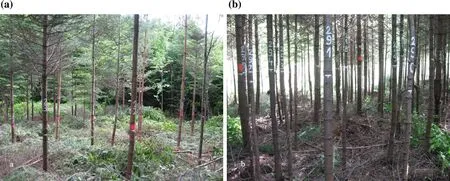
Fig.1 DRP2(a)and DRP3(b)after the intervention in May 2012

Table 1 Initial data(before and after intervention)in May 2012:stocking and basal area
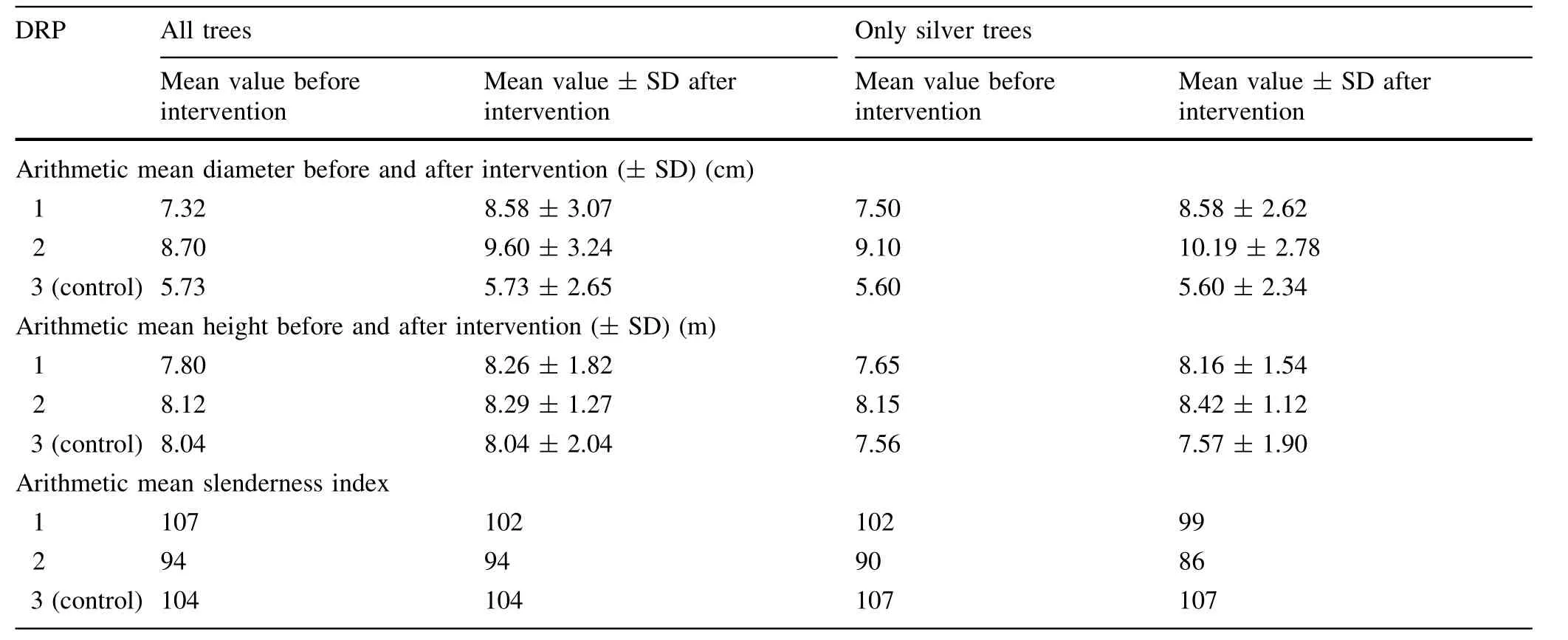
Table 2 Arithmetic mean diameter,mean height and mean slenderness index of initial and remaining trees in 2012
Natural mortality(2012–2016)
Natural dieback,regardless of species,was 0%in DRP1 and DRP2.In DRP3(control),with a very high stocking(over 10,000 trees ha-1)and density(over 31 m2ha-1)in 2012,26 silver fir trees out of 301(8.6%),with diameters between 2.5 and 3.8 cm(over-topped)were dead in 2016.
Individual diameter increments and evolution of arithmetic mean diameter between 2012 and 2016
Between 2012 and 2016,all trees in DRP1 and DRP2 showed diameter increments ranging from 0.2 to 7.3 cm,the highest recorded in DRP2(lowest stocking—ca.1500 trees ha-1and density—ca.12 m2ha-1),whereas a large proportion of trees in DRP3 had no significant diameter increase.
The same positive effect of lower stocking and density on diameter increment was found if considering the proportion of trees with larger diameter increments(3.0 cm or more)between 2012 and 2016(Table 3).
The largest diameter trees had the best growth and correlation between initial dbh(2012)and dbh increment in DRP1 between 2012 and 2016;this is expressed for all trees and only for silver fir,in equations and Fig.4S(Supplementary material):

The mean annual diameter increment between 2012 and 2016 in all plots and only for silver fir is shown in Table 4.
As in previous tables,the increase in arithmetic mean diameter was the highest(3.85 cm=40.1%)in DRP2,as the stocking and basal area were the lowest compared to the other two plots.
Evolution of mean diameter of potential crop trees between 2012 and 2016
The quadratic mean diameter(QMD)of potential crop trees,all trees and only silver fir in the three plots in 2012 and 2016,their increments and evolution during this period,are shown in Fig.2.
The values and evolution of QMD con firm the results in relation to arithmetic mean diameter:the lower stocking and density,the greater the diameter increment.The positive influence on diameter increment was also obvious when considering the evolution of arithmetic mean diameter of potential crop trees compared with non-potential crop trees(NCT—the other trees in DRP1-3)of silver fir(Fig.3).
Evolution of basal area between 2012 and 2016
The effect of higher diameter increments in the lowest stocking and density plot(DRP2)is also con firmed by the evolution of basal area(BA),with a maximum increase of over 92%in DRP2,compared to 61%in DRP1 and only 29%in DRP3(Table 5).
Mean crown diameter
Between 2012 and 2016,the mean crown diameter of all trees increased from 164 cm up to 263 cm(an increment of 99 cm,60.4%)in DRP1,whereas the same parameter increased from 200 cm up to 301 cm(2016)(increment of 101 cm—50.5%)in DRP2.The result was the filling of the canopy gaps created in 2012,almost entirely in DRP1 and to a smaller extent in DRP2,where the canopy of the remaining stand was much lower in 2012.
In DRP1 and DRP2,there is a strong correlation between dbh and mean crown diameter of all trees(Fig.5S):
DRP1:y=15.623x+127.28,R2=0.6023
DRP2:y=12.724x+129.98,R2=0.782
Epicormic branches on silver fir
In 2016,epicormic branches were measured along the pruned part of the silver fir trees.These were found only on trees from the two plots with cleaning-respacing in 2012 and had the following characteristics:(1)DRP1:Epicormics are present on 29.8%of silver fir;number of epicormics per tree:1–21,with an average of 7;length of epicormic branches:2–17 cm,and an average of 7 cm;mean diameter of epicormics at the insertion point:3–4 mm.(2)DRP2:Epicormics are present on 65.8%of silver fir;number of epicormics per tree:2–23,with an average of 8;length of epicormic branches:2–20 cm,and an average of 7 cm;mean diameter of epicormics at the insertion point:3–4 mm.

Table 3 Proportion of trees with various diameter increments between 2012 and 2016

Table 4 Mean annual diameter increment in DRP1-3 between 2012 and 2016
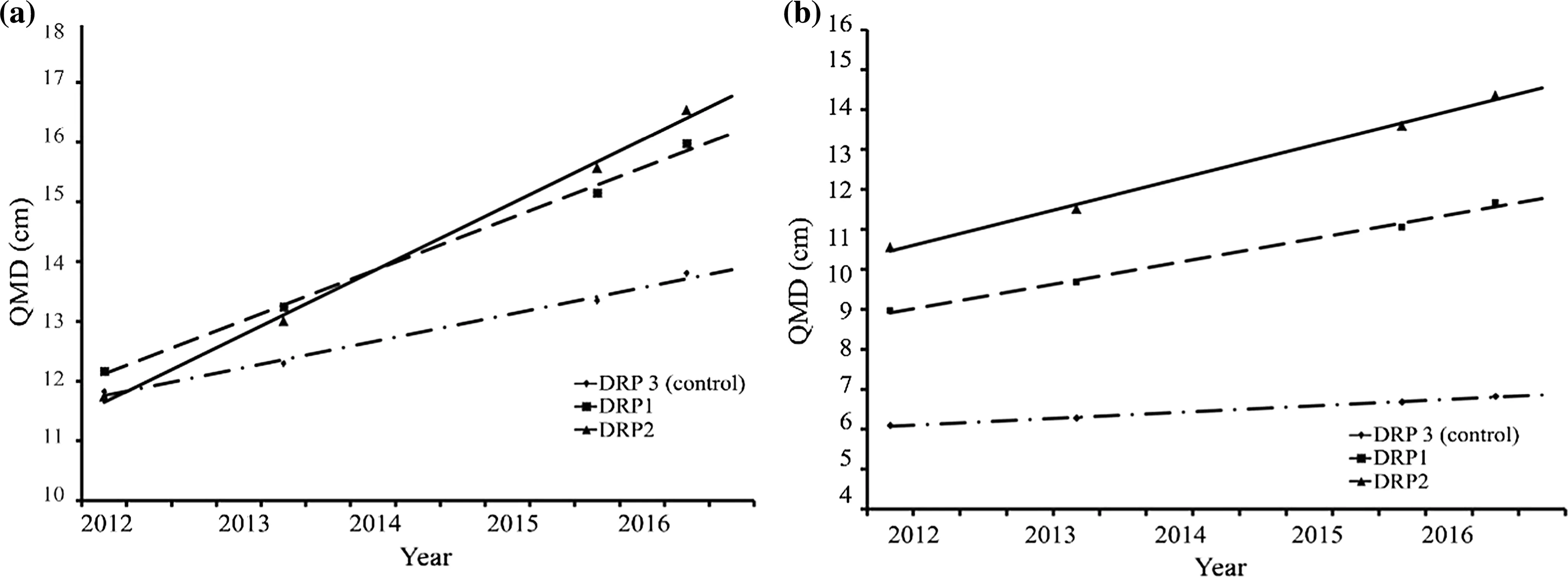
Fig.2 Evolution of quadratic mean diameter of all potential crop trees(a)and silver fir(b)in the three plots in 2012–2016(R=0.99 in all cases)
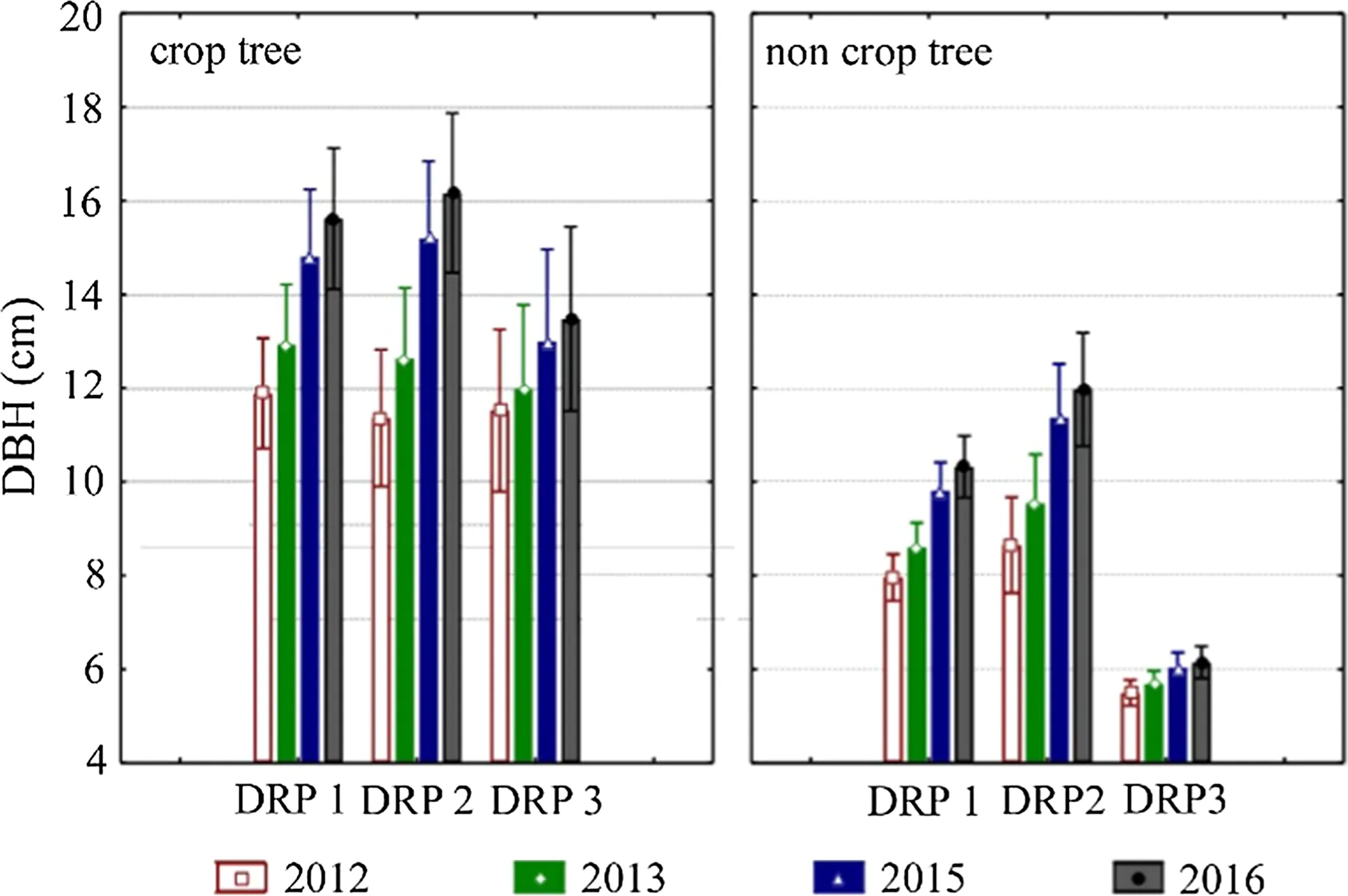
Fig.3 Evolution of arithmetic mean diameter of potential crop trees and non-potential crop trees of silver fir in DRP1-3 between 2012 and 2016
Cankers and witches’broom
These major defects of silver fir were completely eliminated from DRP2 in 2012 as one of the objectives of the very high intensity treatment.They were still present in DRP1(on 23 trees out of 122,18.9%),as the complete elimination of trees with them might have reduced the stocking and density more than targeted.In DRP3,they were present on 15 trees out of 255(5.9%).
Discussion
The initial stand in 2012 was overstocked(>10,000 stems ha-1)and dense(basal area over 31 m2ha-1)in all plots as natural regeneration was high and no interventions(release cutting and first cleaning-respacing)had been carried out.These values are much higher than ones in similar stands of the same age and yield class(ca.5000 trees ha-1and approx.25 m2ha-1),managed with moderate intensity interventions(6–15%by volume)(Giurgiu and Drăghiciu 2004).This study allowed for very high intensity interventions(over 25%)in DRP1 and DRP2,reducing the stocking and basal area to values lower than the threshold ones.As the dominant height of silver fir in the three DRPs after cleaning-respacing in 2012 was approximately 10.0 m(from 9.8 m in DRP 3 up to 10.4 m in DRP2),the remaining stocking in DRP2(ca.1400 trees ha-1)is similar to that proposed in the French guidelines for silver fir silviculture(1400–1500 stems ha-1at 10–11 m dominant height on fertile sites(Demarcq et al.1996).At the sametime,taking into account the values of basal area in DRP1 and DRP2 in 2012,the remaining stocking and density in the two plots were much lower than the maximum basal area(approx.45 m2ha-1)and maximum stem numbers(ca.5700 stems ha-1)for silver fir stands in Austria(Vospernik and Sterba 2015),according to the Reineke’s rule which explains the absence of tree mortality in these plots.

Table 5 Basal area in 2016 and increment in basal area between 2012 and 2016
The application of cleaning-respacing in 2012 provided the opportunity to reduce the share of silver fir in the initial stand.The proportion of silver fir in DRP1-3 before the treatment ranged from 80%(DRP2)to 90%(DRP1),and was reduced to 70 and 87%in DRP2 and DRP1 respectively(Table 1).The improvement of species composition is one of the main tasks in such stands:the avoidance of pure silver fir stands and a change to admixtures,with both conifer(mainly Norway spruce but also Scots pine)and broadleaved species(European beech,hornbeam),and maximum 50–70,even 80%silver fir,will diversify wood production and increase forest resilience to climate change,pests and diseases,is advocated in Romania(CMDPA 1986;MAPPM 2000a)and abroad(Demarcq et al.1996;Vallet and Pérot 2011;Kerr et al.2015).Such stands,with trees intimately(individually or in small groups)mixed and irregularly structured due to the presence of broadleaves mostly in the lower canopy,can play multiple functions such as protection from disease and insect outbreaks,resistance to wind damage and other abiotic stresses,risk reduction and compensatory growth,maintenance of landscape aesthetics,conservation of native plant and animal species(Kelty 1992).
The very heavy cleaning-respacing treatments,mostly from below,in agreement with the current prescriptions for Romanian stands facing climate changes(Barbu et al.2016),have positive effects on mean diameters and heights(increase)and mean slenderness indices (decrease),improve stand stability and reduce the risks of snow damage.
As the heavy treatments in DRP1 and DRP2 reduced the competition for site resources(including light),there was no tree mortality in these plots compared to the high level(8.6%)in the control plot which had higher stocking and density where mainly silver fir from the lower canopy died.
In terms of diameter increment,the highest values were recorded in the DRP2,with the lowest stocking,basal area,and crown competition because a greater increase in diameter is more effective after treatment.Under the very crowded conditions of DRP3,many trees exhibited no diameter increment.In direct relation with the higher levels of diameter increment of individual trees in DRP2,the increase of basal area was the highest in this plot.The values of basal area,strongly reduced through the treatment in Barbu(2012),are currently(Barbu et al.2016)quite close to the “target”of 25 sq.m ha-1in DRP2 and already higher than this in DRP1.
There is a strong linear(Giurgiu 1967)correlation between the initial(Barbu 2012)diameter of remaining trees and their increment,the largest being the more rapid growers as noted by von Gadow and Hui(1999).
The positive effects of the lowest stocking/density on diameter increment was most obvious in the potential crop trees(large diameters with broad,balanced crowns,without defects,as evenly spaced as possible),favoured during cleaning-respacing in order to reduce the level of competition in the upper canopy.
These trees are more numerous(400–518 stems ha-1)in the three DRPs than the number proposed in the silver fir stands in France which ranges from 200 up to 280 trees per ha,6–7 m apart,and selected when the trees reach at least 15 cm in diameter(Allegrini and Depierre 2000;Bastien 2001;Allegrini 2010).Our decision to select earlier and mark them as potential crop trees during cleaning-respacing,rather than during the first or second thinning,was based on the fact that trees are already obviously individualized in terms of vigorousness(combined diameter and height)and their early diameter growth can be favoured by respacing and interventions at crown level around them.However,the number of such individuals will be reduced during the subsequent 2–3 thinning to similar levels as in France,as the current distances between their crowns are quite short and the trees are predisposed to high crown competition levels.In addition,the first thinning,which will be carried out within 2–3 years,will also be heavy but mostly from above and targeting the development of the PCT crowns.This approach(selection of crop trees and interventions from above around their crowns)is one of the newest solutions proposed in Romanian silviculture to reduce water stress and the effects of summer droughts in the context of potential climate changes(Barbu et al.2016).
Epicormic branching is a common feature within silver fir forests(Stănescu 1979).Such branches can occur as symptoms of decline(Oliva and Colinas 2007;Barbu 2012)on suppressed trees with reduced cambial activity(Barbu 2012),or on trees suddenly exposed to light,a normal reaction for a shade-tolerant species(Stănescu 1979;Stă-nescu et al.1997).The reduction of stocking and basal area in DRP1 and DRP2,leading to a high amount of light within the stand,favoured the occurrence and growth of epicormics.Under this special light regime,the less vigorous trees with smaller crowns were the most prolific producers of epicormics in both plots,with the highest number of branches in the upper parts of the bole near the live crown as also shown by Meier et al.(2012).As expected,owing to much higher illumination within DRP2,this plot had the highest proportion of trees with epicormics.However,the number of epicormics per tree,their length,and their diameters at the insertion point on the trunk were similar in the two DRPs with interventions in 2012.
The application of cleaning-respacing in 2012 also provided the opportunity to reduce or even eliminate the cankers and witches’brooms,as their mechanical control by cutting the affected branches or felling the trees with these defects is the only way to prevent their undesired effects or development of disease(Georgescu et al.1957;Marcu 2005;Solla et al.2006).In this respect,the extraction of infected trees is necessary as they seem to be highly sensitive to late frosts(Solla et al.2006),and the presence of the canker exposes the trees to wind and snow breaks(Negulescu and Săvulescu 1957,1965;Haralamb 1967).The diameter and volume growth can be reduced(Georgescu et al.1957;Solla et al.2006),and the fissured bark of swellings is an entry point for rot-producing fungi such as Phellinus hartigii(Allesch.&Schnabl)Pat.or xylophagous insects(Georgescu et al.1957;Gilbertson and Ryvarden 1987;Marcu 2005).
Conclusions
Cleaning-respacing treatments at intensities higher than those legally recommended in Romania are beneficial in silver fir-dominated stands for the remaining stand as trees growing under lower stand stocking and density have higher rates of diameter increment.
The selection and marking of crop trees can begin during the application of cleaning-respacing.Such valuable trees are the best growers and therefore shorter rotation ages and reduced impact of root and butt rot related to longer rotation ages is possible.
Artificial pruning is important for providing better accessibility in densely regenerated stands as well as for producing knot-free wood.However,such a costly intervention is economically feasible only when a market for A-grade lumber or resonance wood(for the production of musical instruments)exists.
However,our results are from a single case-study from one location without replicates and care should be taken in extrapolating these findings to other sites and stand conditions.In addition,these results do not provide information on the duration of the positive effects of cleaningrespacing on diameter growth beyond this period,when the subsequent intervention( first thinning)should be performed,or what the stocking/density should be after this intervention.
However,silver fir is a climate-sensitive species(Linares and Camarero 2012;Mazza et al.2014),with dieback triggered by severe droughts(Sangüesa-Barreda et al.2015),and populations located outside the Mediterranean area(including Romania)have shown a clear increase in growth over the last decades(Gazol et al.2015).In these conditions we believe that larger-scale establishment of demonstration plots on other-than-usual silvicultural interventions in young stands and short-and mediumterm monitoring of silver fir evolution under the expected climate change conditions can provide useful information for practical forestry.
AcknowledgementsWe thank Dr.Aurica Pătrăucean(LIGNUM Forest District)and numerous undergraduate and postgraduate students from the Faculty of Silviculture and Forest Engineering(Brasov)for the field work.We also wish to express our thanks to the anonymous reviewers for their constructive criticisms.
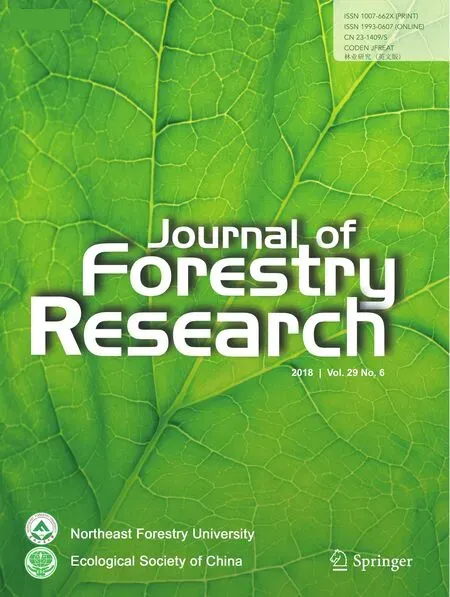 Journal of Forestry Research2018年6期
Journal of Forestry Research2018年6期
- Journal of Forestry Research的其它文章
- Black locust(Robinia pseudoacacia L.)as a multi-purpose tree species in Hungary and Romania:a review
- The impact of the environmental factors on the photosynthetic activity of common pine(Pinus sylvestris)in spring and in autumn in the region of Eastern Siberia
- Osmoregulators in Hymenaea courbaril and Hymenaea stigonocarpa under water stress and rehydration
- Effect of nitrogen levels on photosynthetic parameters,morphological and chemical characters of saplings and trees in a temperate forest
- Free amino acid content in trunk,branches and branchlets of Araucaria angustifolia(Araucariaceae)
- Exogenous application of succinic acid enhances tolerance of Larix olgensis seedling to lead stress
